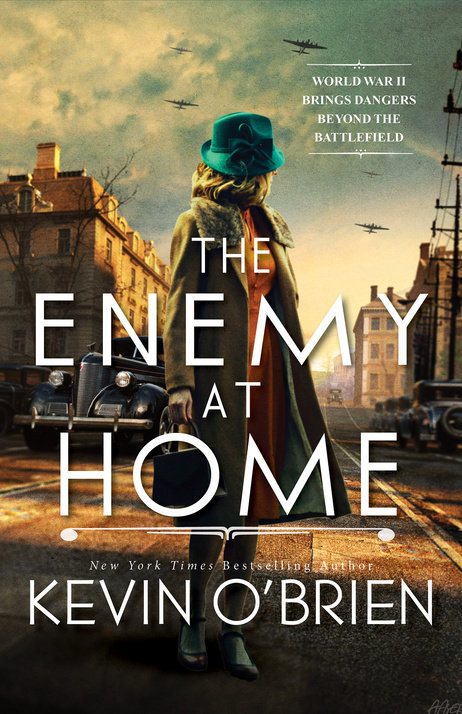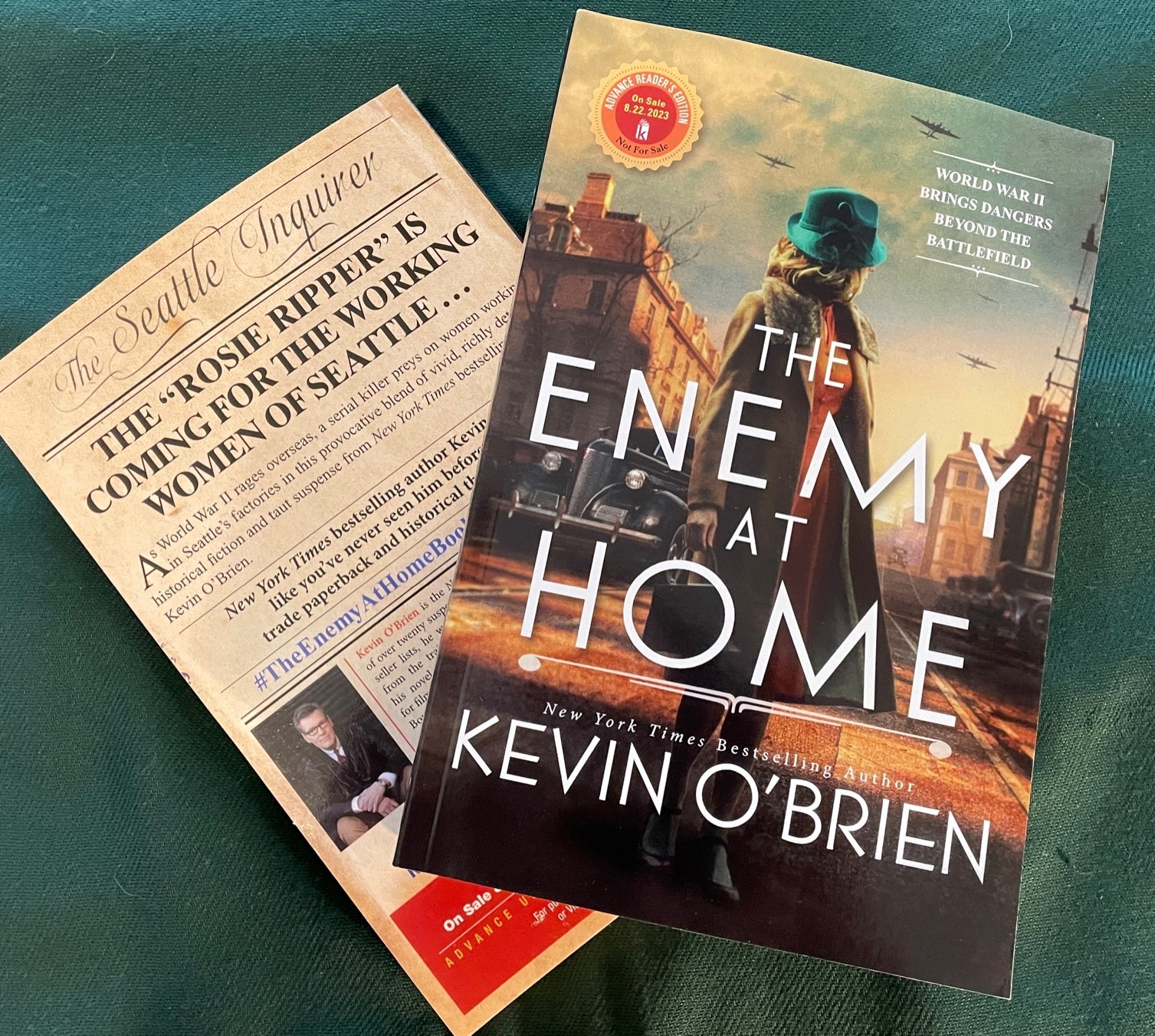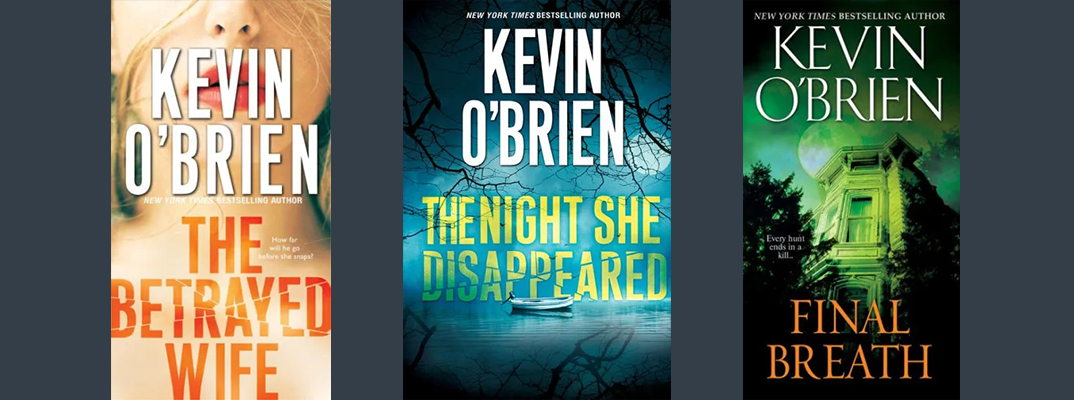The Enemy at Home by Kevin O’Brien

INTERVIEW WITH kevin o’brien
August 10, 2023
GENERAL QUESTIONS
How do you begin /get started on writing a new novel?
I’ll get an idea—or my editor (with whom I have a 27-year working relationship) will pitch an idea my way. Then I start asking “What if?” and “Why?” and I jot down random notes and develop potential characters. I’ll run certain things past my editor, and if we’re both still excited about the idea, then I’ll start working on a detailed outline (about 80 pages—it reads like a mini-novel). My editor usually gives me some notes along with the go-ahead to write the book. So—by the time I deliver my first draft, he already has a good idea of what he’s getting. It’s a pretty unique system between writer and editor, but it really works for us.
What was your favorite book as a child?
I was reared in the classics, so at age seven and a half, I read The Iliad by Homer, and was enthralled. Okay, I’m kidding. My favorite book was MORRIS IS A COWBOY (story and pictures by B. Wiseman). It’s an “I Can Read” book, in which Morris the Moose is a Policeman, Baby Sitter and a Cowboy. I still have it!
Do you listen to music while you write, or do you need complete silence?
I need music! I usually listen to an oldies station. I can sing all the songs by The Seekers, The Beach Boys, The Monkeys and Del Shannon, but couldn’t name one Taylor Swift song—even if my life depended on it. Good thing THE ENEMY AT HOME isn’t a contemporary thriller. I’d be totally lost making any timely music references.
Do you think being a writer isolates you or connects you to other people?
Being a writer is terribly isolating. The only way I can make any progress on a book is to shut myself away from everything and everyone, get out what Stephen King calls the “butt-glue”, sit down and write. During this phase, I isolate myself and pray the book will make a connection with people. It’s pretty ironic now that I think of it!
What advice would you give to a new writer?
That goes hand in hand with your last question. The task of writing is so isolating. Writers need a support group of some sort. I always recommend new writers start or join a writers’ group. Writing classes at local community colleges are one way to meet other writers. If you can connect with just one or two people in that class, you’ll have someone to give you feedback on your writing and commiserate with you about breaking into the business. There’s strength in numbers!

KEVIN SPECIFIC QUESTIONS
You are a New York Times and USA Today bestselling author who’s written more than 20 contemporary thrillers, but THE ENEMY AT HOME is a big departure for you. What made you decide to make this shift to historical fiction?
I got the idea for THE ENEMY AT HOME about twelve years ago. I was enthusiastic about this story of a serial killer—set on the Homefront during WWII, about 30 years before the term “serial killer” was even coined. But when I pitched it to my editor, he didn’t think the timing was right. My contemporary thrillers were selling well. Why rock the boat with historical fiction? I saw his point. So, I put the idea away. But I didn’t forget it. Then I hit retirement age in 2020. After all those contemporary thrillers (one every year for twenty years), I decided to shake things up a bit. I pitched my WWII story to my editor again, and this time, he felt the timing was perfect—especially if we blended the genres to create a historical thriller. I think, sometimes, the best projects are ones that are years in the making!
While THE ENEMY AT HOME takes place during WWII, it’s not a “typical WWII novel” because it doesn’t take place in Europe and provides a very different experience of wartime. Can you speak about the setting and what drew you to this perspective?
When I was a kid, I saw an old David O. Selznick movie, SINCE YOU WENT AWAY, in which Claudette Colbert and her daughters, Shirley Temple and Jennifer Jones, carry on valiantly on the Homefront while the husband/father is away fighting in Europe. The movie—which touched upon wartime rationing, defense work, rehabilitation of vets and mostly waiting out the war with uncertainty—really stayed with me. I decided it was an ideal setting/period for a thriller—a time that brought out the very best and worst in people.
During your research into WWII-era Seattle, did you come across anything you found particularly surprising or fascinating?
Seattle went through a boom during the war, ranking as one of the top three cities in defense contracts. Boeing, where my ENEMY AT HOME heroine Nora works, made B17 and B29 bomber planes. Seattle shipyards produced battleships, destroyers, minesweepers, aircraft carriers and other vessels for the war effort. Until I started doing the research, I hadn’t realized that, during the war, Seattle had strictly-enforced citywide blackouts. Streetlights and store signs went off at 11 PM. Porchlights shut off, and shades or special blackout curtains were drawn. The blackouts lead to a spike in automobile accidents and crime. But the darkness shrouding the city helped protect against possible attacks from enemy planes and subs. And of course, a blacked-out city is also the perfect setting for a suspense thriller.
The fear of enemy invasion or attack was very real. With all of its defense plants and military bases, Seattle was a logical prime target. It was the first city to have an air raid drill. And at Boeing’s B17 plant, they created a special roof to throw off potential aerial attacks. Hollywood set designer, John Stewart Detlie, fashioned a fake “residential town” with half-sized plywood houses, streets, and burlap trees and bushes. From the air, it looked like a sleepy little neighborhood—while below, they churned out fighter planes that would help turn the tide of the war.
What do you like most about Nora, the protagonist of your novel?
Nora is a 37-year-old mother of two. While her doctor husband is in North Africa with the Army Medical Corps, Nora joins the army of women war workers—as a riveter at Boeing. She’s a bit like George Bailey in IT’S A WONDERFUL LIFE. There’s a line in the movie where George’ father tells him that he was “born old.” That’s Nora, too, beset with a lot of responsibilities at an early age. As a preteen, she was forced to look after her kid brother, and she married young. Like George Bailey, she always wanted to travel. But by the time she was old enough, she had kids—and besides, the entire world was on the brink of war. What I like best about Nora is that she has a strong sense of duty and accountability. She always wants to do the right thing.
Throughout THE ENEMY AT HOME, Nora encounters racism, misogyny and homophobia—which were all heavily common and sometimes even endorsed during this time. How does Nora’s background and circumstances influence her response to each of these encounters? Did you face any challenges in depicting these injustices?
When I started writing the book, I figured I could show Nora having her eyes opened to different injustices; but during that time period, it would have been anachronistic for her to take a strong stand against the socially-accepted racism and homophobia of the time. There’s a scene of her paired up with a Black man on a riveting job—that was strongly influenced by a story in Emily Yellin’s OUR MOTHER’S WAR and one of the many documentaries I watched. She gets along too well with him, and is criticized for it. But she doesn’t take a stand. She can’t afford to. However, Nora does take some steps to counteract the prevailing prejudices—like holding onto family keepsakes for her Japanese-American friend, who is in an internment camp. She stands up for a closeted homosexual accused of murder. And she sits in the unofficial “colored” section in the work cafeteria. She’s not exactly a crusader, but she does take some small steps against injustice.
What would you like readers to take away from THE ENEMY AT HOME?
First of all, I want the reader to have been entertained—and yes, enlightened, too. I hope, among readers, it’ll spark an interest in WWII. How we acted in that time of crisis is very relevant today. We’re just emerging from a three-year crisis with the pandemic. While I was writing this book, I couldn’t help wondering how we compared with “the greatest generation” when asked to make sacrifices and “do our bit.” As I said before, WWII brought out the best and worst in people, and we can learn from it.
Previous novel by author


0 Comments